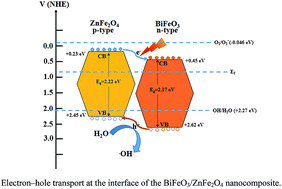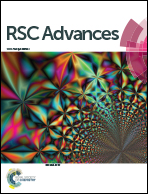Photocatalytic activity of BiFeO3/ZnFe2O4 nanocomposites under visible light irradiation†
Abstract
Herein, BiFeO3/ZnFe2O4 nanocomposites were synthesized via a glyoxylate precursor method using a two-pot approach. Phase evolution is investigated by X-ray diffraction and Raman spectroscopy, which confirm that no impurity phases are formed between BiFeO3 and ZnFe2O4 following calcination at 600 °C. The specific surface area characterized by N2 adsorption–desorption isotherms decreases from 30.56 to 13.13 m2 g−1 with the addition of zinc ferrite. In contrast, the magnetization increases from 0.28 to 1.8 emu g−1 with an increase in the amount of ZnFe2O4. The composites show strong absorption in the visible region with the optical band gap calculated from the Tauc's plot in the range from 2.17 to 2.22 eV, as measured by diffuse reflectance spectroscopy. Furthermore, the maximum efficiency for the photodegradation of methylene blue under visible light is displayed by the composite containing 25 wt% ZnFe2O4 due to the synergic effect between BiFeO3 and ZnFe2O4, as confirmed by photoluminescence spectroscopy.



 Please wait while we load your content...
Please wait while we load your content...